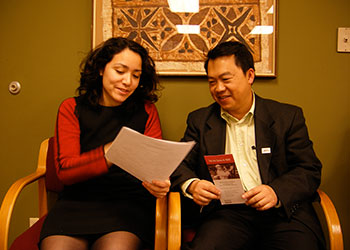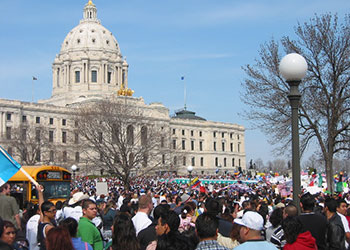News > Fact Sheets
Quick Facts About Asylum

Posted on Jul 18 2019
(For a printable PDF version of this Fact Sheet click here.)
What is Asylum?
An asylee, a person granted asylum, is a person who has to flee their country of origin due to persecution, or fear of persecution, based on their race, nationality, political opinion, religion or membership in a particular social group. While asylum is not a permanent legal resident status, asylees may apply for a green card one year after receiving asylum in the United States.
Asylees receive protection from being returned to their country of origin, are authorized to work in the United States, may apply for a social security number, and may petition to bring family members to the United States.
What is the normal asylum process?
U.S. asylum applications may take two forms: affirmative and defensive. An asylum applicant must be physically present in the United States or at a port of entry to apply. They may apply regardless of how they entered the country.
Under the affirmative asylum process, individuals must usually apply within one year of arrival to the United States, or immediately upon arrival at a port of entry. An affirmative application is made to a United States Citizenship and Immigration Services (USCIS) officer, who then decides whether to grant asylum.
In the defensive asylum process, individuals can seek asylum as a defense against removal after U.S. Immigration and Customs Enforcement (ICE) or Customs and Border Protection (CBP) apprehends them without a valid visa inside the United States or at a port of entry. A person in the defensive asylum process is already in removal proceedings and requests asylum in immigration court. An immigration judge decides whether or not to grant asylum.
If a USCIS officer denies an affirmative application after the individual’s visa has expired, the individual is referred to removal proceedings where they can use the defensive asylum process to renew their request for asylum.
A person subject to expedited removal must indicate that they have a credible fear of returning to their country of origin. The “credible fear interview” is ordinarily conducted by a trained USCIS officer. However, in the summer of 2019, the administration ordered that credible fear interviews will be conducted by Border Patrol officers.
If the officer says that the individual does not have credible fear, authorities refer them for removal. They can then appeal the negative decision to an immigration judge.
How long does the asylum process take?
The length of the asylum process varies from six months to several years. The length of time needed to process an application depends significantly on whether it is an affirmative or defensive claim, and on the individual circumstances of the case. Under the defensive system, applicants must go through the immigration court system, which faces significant backlogs. According to the Transactional Records Access Clearinghouse, as of July 2019, there were over 900,000 pending cases with an average wait time of 727 days. The backlog continues to worsen with funding for immigration judges failing to keep pace with the need to hire more judges.
What are the acceptance rates?
In FY 2018, 22,740 individuals were granted asylum, about 35 percent of the 64,974 individuals who underwent asylum decisions. Most asylum seekers come from China, El Salvador, Honduras, Guatemala and Mexico.
Denial Rates
Denial rates on asylum decisions increased in 2018, with 65 percent of asylum petitions denied, compared to a 42 percent denial rate in 2012 and a 50 percent denial rate in 2016. In 2018, Attorney General Jeff Sessions ordered that claims of domestic violence and gang violence could no longer be used as a basis for asylum applications. That order was one of the reasons causing the rate of asylum denials to increase during the Trump Administration.
Applicants who have attorneys have a far higher approval of asylum petitions, compared to those without representation. The process is extremely complicated, and navigating immigration courts without an attorney is difficult.
Applicants who are held in detention have lower rates of approval of their asylum claims than those who are free in the community. Locating documents, witnesses and evidence needed to support an asylum claim is extremely difficult for an applicant who is held in detention.
How is asylum changing?
In January 2019, the Department of Homeland Security implemented the “Migrant Protection Protocols” (MPP) also known as “Remain in Mexico”, sending asylum seekers back to Mexico and forcing them to wait there for the completion of their immigration court proceedings. This, in effect, denies asylum seekers the protection allowed to them under international and U.S. immigration law. In many cases, asylum seekers in Mexico face the very dangers they fled, as well as having difficulty in finding places to stay and in making contact with attorneys or getting notice of court dates.
Metering
Metering is a term that Customs and Border Protection uses for a process by which it severely restricts the number of people who can request asylum at a port of entry or at a U.S.-Mexico border crossing each day. When asylum seekers reach a port of entry, they are turned away and told that they have to put their name on a waiting list. As a result of these lists, asylum seekers wait for weeks, sometimes months for an opportunity to request asylum. As of late June 2019, 19,000 asylum seekers were waiting on the Mexican side of the border for a chance to request asylum in the United States. After going through the metering process, asylum seekers then seek asylum, but most are required to remain in Mexico while the U.S. government processes their asylum application. Metering has resulted in potential asylum seekers crossing the border without authorization rather than waiting for a process that is rife with corruption and uncertainty.
Ending Asylum at the Southern Border
On July 15, 2019, the Trump administration issued a new regulation that effectively ends amnesty for any migrants arriving at the U.S. – Mexico border if they have traveled through another country. The new rule covers everyone except Mexican and Canadian citizens. The rule denies people who have traveled through a third country any opportunity to apply for asylum in the United States unless they have applied for and been denied asylum in that third country. The rule nullifies national and international obligations to protect asylees.
Several organizations, represented by attorneys from the ACLU, Center for Constitutional Rights, and Southern Poverty Law Center, filed a lawsuit on June 16 asking a federal court to declare this regulation invalid and enjoin the administration from enforcing it.
Other pending lawsuits challenge the metering and Remain in Mexico policies.




